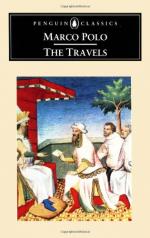[FURTHER PARTICULARS CONCERNING THE GREAT CITY OF KINSAY.[NOTE 1]]
[The position of the city is such that it has on one side a lake of fresh and exquisitely clear water (already spoken of), and on the other a very large river. The waters of the latter fill a number of canals of all sizes which run through the different quarters of the city, carry away all impurities, and then enter the Lake; whence they issue again and flow to the Ocean, thus producing a most excellent atmosphere. By means of these channels, as well as by the streets, you can go all about the city. Both streets and canals are so wide and spacious that carts on the one and boats on the other can readily pass to and fro, conveying necessary supplies to the inhabitants.[NOTE 2]
At the opposite side the city is shut in by a channel, perhaps 40 miles in length, very wide, and full of water derived from the river aforesaid, which was made by the ancient kings of the country in order to relieve the river when flooding its banks. This serves also as a defence to the city, and the earth dug from it has been thrown inwards, forming a kind of mound enclosing the city.[NOTE 3]
In this part are the ten principal markets, though besides these there are a vast number of others in the different parts of the town. The former are all squares of half a mile to the side, and along their front passes the main street, which is 40 paces in width, and runs straight from end to end of the city, crossing many bridges of easy and commodious approach. At every four miles of its length comes one of those great squares of 2 miles (as we have mentioned) in compass. So also parallel to this great street, but at the back of the market places, there runs a very large canal, on the bank of which towards the squares are built great houses of stone, in which the merchants from India and other foreign parts store their wares, to be handy for the markets. In each of the squares is held a market three days in the week, frequented by 40,000 or 50,000 persons, who bring thither for sale every possible necessary of life, so that there is always an ample supply of every kind of meat and game, as of roebuck, red-deer, fallow-deer, hares, rabbits, partridges, pheasants, francolins, quails, fowls, capons, and of ducks and geese an infinite quantity; for so many are bred on the Lake that for a Venice groat of silver you can have a couple of geese and two couple of ducks. Then there are the shambles where the larger animals are slaughtered, such as calves, beeves, kids, and lambs, the flesh of which is eaten by the rich and the great dignitaries. [NOTE 4]
Those markets make a daily display of every kind of vegetables and fruits; and among the latter there are in particular certain pears of enormous size, weighing as much as ten pounds apiece, and the pulp of which is white and fragrant like a confection; besides peaches in their season both yellow and white, of every delicate flavour.[NOTE 5]




